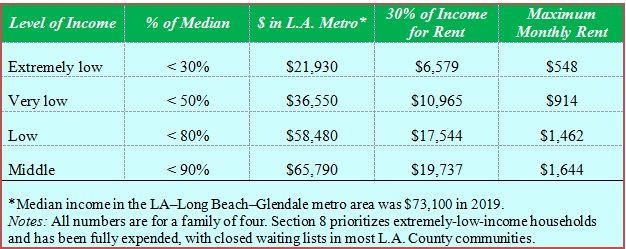Affordable Housing Basics
Habitat for Humanity defines a decent place to live as:
- affordable
- secure
- capable of safeguarding a family’s health
- accessible [to the disabled]
- safe
- able to connect families to opportunity
Our three panelists were asked to help us understand the need for affordable housing and the role government plays in building new housing or rehabilitating existing housing to meet that need.
The federal government defines affordable as not exceeding 30 percent of a family’s median income. That is the cost for securing an apartment or a house. The Housing Subcommittee has learned that more than 50 percent of the families in our area rent, and almost 50 percent of those families spend more than 30 percent of their income on rent.

William Huang, Director of Housing for the City of Pasadena, started the meeting with the statement that affordable housing is typically not economically viable, because the cost of land and construction cannot be recovered with affordable rents. Government helps with subsidies for capital, rent, and service (utilities). These take the form of city-owned land, below-market loans, tax credits, and bonds.
A second way local government can affect the amount of affordable housing that is built is to require it. Pasadena and other area municipalities use a tool called “inclusionary zoning” to require that a number of units in any large development be made available at affordable rates. If the builder does not want affordable units in that project, they must be built at another site or the cost of building comparable units must be paid into a city fund for affordable housing.
Finally, cities use other major tools to incentivize affordable housing development: density bonuses (to build more units than otherwise would be allowed), fee reductions or waivers, and property tax waivers.
Anne Miskey, CEO of Union Station Homeless Services, addressed the intersection of homelessness and affordable housing. She reviewed some of the appalling statistics on homelessness (including that there are only 30 units of housing for every 100 very-low-income folks who need a home) and the history of our response to it. For a long time, shelters were seen as the solution, but shelters are by nature temporary, and agencies and governments have largely switched to a “housing first” approach to getting people off the streets and into permanent housing. This approach links supportive services to the development of permanent housing and provides services (emotional, physical, and economic) that keep people in safe apartments. Individuals are required to pay 30 percent of their income for rent.
Our third panelist, Cynthia Kurtz, is an adviser to National CORE, a nonprofit affordable home builder. She outlined the many steps that must be taken at the local, state, and national levels to expand the supply of affordable housing. At the local level, the biggest problem is NIMBYism (NIMBY = “not in my back yard”). Resistance to projects in neighborhoods is one of the largest impediments to building. She demonstrated that affordable housing does not reduce the value of other homes in the neighborhood. When neighbors support projects, those projects are usually successful.
At the county and state levels, Kurtz noted that support comes from programs like tax credits, which need to be expanded. Hindrances often come in the form of land-use rules that limit where affordable but not market-rate housing can be built. Wherever possible, surplus state and local land should be made available for affordable housing projects.
And at the federal level, expanded support for construction of new housing and the Section 8 rental voucher program would strengthen efforts to get more affordable housing built. Section 8 pays the difference between 30 percent of a household’s income and market rate, making it much easier for a landlord to maintain affordable units.
The Housing Subcommittee and our speakers would like you to understand this essential fact about the need for affordable housing: Almost all low-income people work and do their best to pay their rent, but the cost of rent is unsustainable to them at market rates. This leaves them unable to pay a market-rate rent and have enough left over to meet their basic human needs: food, clothing, transportation to work, and health care. We need low- and middle-income workers to build more housing, teach our children, staff our restaurants, provide childcare, clean our homes and businesses, take care of our elderly, provide retail services—and the list goes on. As every community needs these workers, every community needs to provide them with affordable housing.
This event was recorded on video, which can be accessed through the League
YouTube Channel along with the slides from our speakers.
—Anita Mackey, Chair, Advocacy Committee